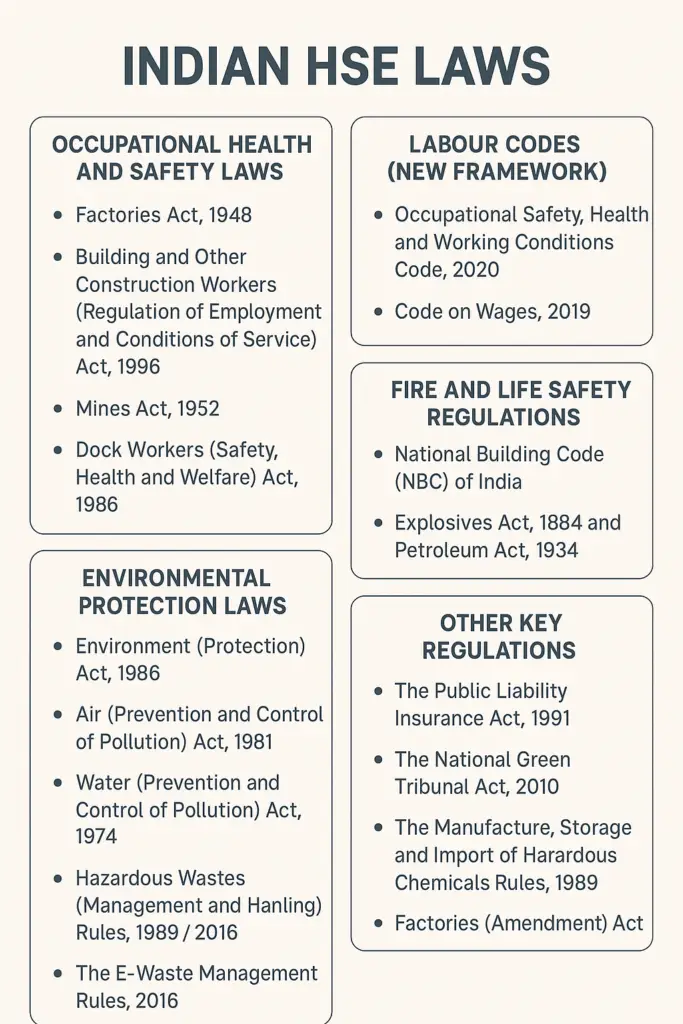
Indian HSE (Health, Safety, and Environment) laws are a comprehensive set of legal frameworks designed to protect workers’ health and safety, promote environmental sustainability, and ensure safe working conditions across industries. Here’s a categorized overview of key Indian HSE laws:
1. Occupational Health and Safety Laws
A. Factories Act, 1948
Primary legislation for health, safety, and welfare of workers in factories.
Covers provisions related to:
Working hours, safety measures, machinery guarding
Occupational health (ventilation, lighting, cleanliness)
Welfare (drinking water, sanitation, canteens)
B. Building and Other Construction Workers (Regulation of Employment and Conditions of Service) Act, 1996 (BOCW Act)
Applicable to construction workers and contractors.
Mandates safety measures, accident prevention, welfare facilities.
C. Mines Act, 1952
Applicable to mining operations.
Provides for the health, safety, and welfare of workers in mines.
D. Dock Workers (Safety, Health and Welfare) Act, 1986
Ensures safety in dock work operations.
2. Labour Codes (New Framework)
India has consolidated 29 labor laws into 4 labor codes, of which two impact HSE directly:
A. Occupational Safety, Health and Working Conditions Code, 2020
Replaces multiple acts (Factories Act, Mines Act, BOCW, etc.)
Key features:
Applicability to all establishments with 10 or more workers
Mandatory health and safety standards
Appointment of safety officers, safety committees
Worker rights and duties defined
B. Code on Wages, 2019
Though not directly HSE-related, ensures fair wages and minimum standards affecting overall worker welfare.
3. Environmental Protection Laws
A. Environment (Protection) Act, 1986
Umbrella act for environment protection.
Empowers the central government to regulate emissions, waste management, hazardous substances.
B. Air (Prevention and Control of Pollution) Act, 1981
Controls and abates air pollution.
C. Water (Prevention and Control of Pollution) Act, 1974
Prevents and controls water pollution.
D. Hazardous Wastes (Management and Handling) Rules, 1989 / 2016
Management and disposal of hazardous waste by industries.
E. The E-Waste Management Rules, 2016
Guidelines for handling and disposal of electronic waste.
F. The Plastic Waste Management Rules, 2016
Mandates proper segregation, collection, and disposal of plastic waste.
4. Fire and Life Safety Regulations
A. National Building Code (NBC) of India
Guidelines for fire prevention, fire protection, life safety, and emergency response in buildings.
B. Explosives Act, 1884 and Petroleum Act, 1934
Governs manufacture, transport, storage of hazardous/explosive materials.
5. Other Key Regulations
The Public Liability Insurance Act, 1991 – Compensation for victims of accidents due to hazardous substances.
The National Green Tribunal Act, 2010 – Establishes the NGT for fast-track environmental justice.
The Manufacture, Storage and Import of Hazardous Chemicals Rules, 1989 – Risk management and emergency response for hazardous chemicals.
Factories (Amendment) Act (State-wise) – Several states have added stricter provisions.
